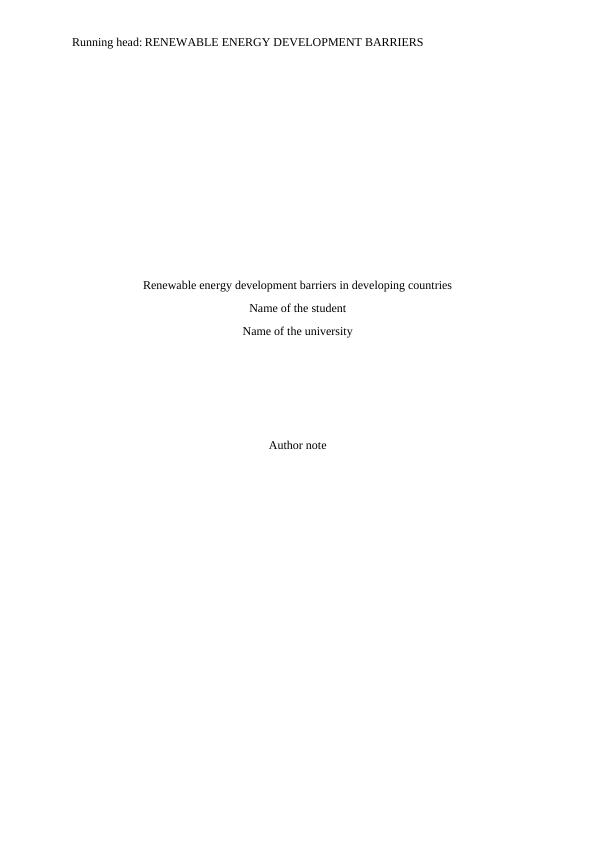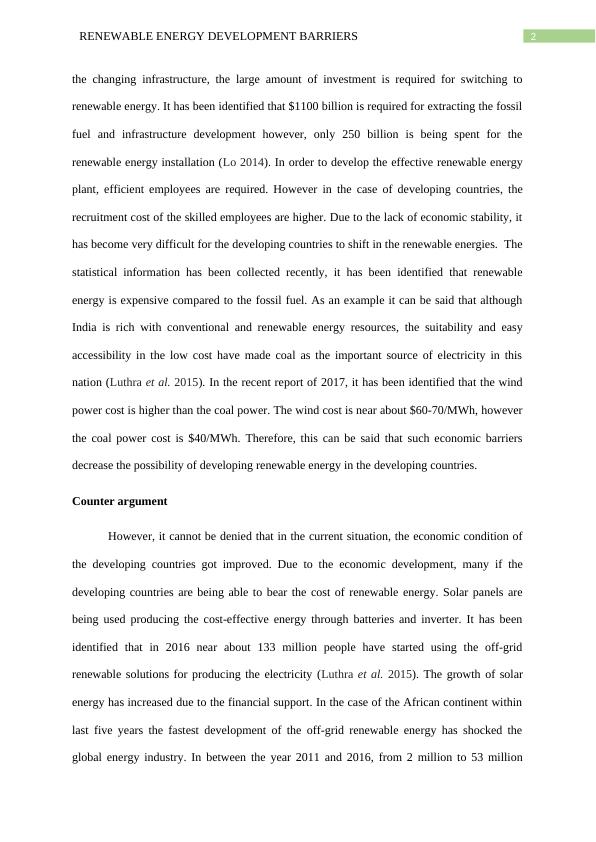Renewable Energy Development Barriers in Developing Countries
Added on 2023-06-08
9 Pages2093 Words218 Views
Running head: RENEWABLE ENERGY DEVELOPMENT BARRIERS
Renewable energy development barriers in developing countries
Name of the student
Name of the university
Author note
Renewable energy development barriers in developing countries
Name of the student
Name of the university
Author note

1RENEWABLE ENERGY DEVELOPMENT BARRIERS
Introduction
In the current scenario, demands for sustainable energies in the global energy market
has increased. Due to the depletion of fossil fuel demand for alternative renewable energies
have increased. It has been identified that wave and water produce the renewable energy that
can be used for sustainable development. It is true that most of the developing countries are
rich in the case of renewable source. Due to this reason, the importance of renewable energies
in the global context has been highlighted in the developing countries. It cannot be denied
that improper economic structure and lack of government support, various challenges are
being faced by the developing countries in order to develop renewable energies. In the case of
developing countries various, governmental and economic policy barriers interrupt in the case
of shifting to alternative renewable energy sources. It cannot be denied that switching from
fossil fuel to renewable energy can bring the solution for these challenges. Moving from
fossil fuel to renewable energy is a long-term process.
Issue 1
Argument
In the current situation people have become habituated with the non-renewable
energies, due to this reason, developing countries are sticking in the fossil fuels. The process
of renewable energy production is uncertain and quite slow, which is creating the challenges
for developing countries. It cannot be denied that the renewable energy growth in the
developing countries has various limits for dealing with the funds, technology, improper
infrastructure and energy policy related issues. As the fossil fuel is reliable and affordable,
hence, the developing nations will depend on the fossil fuels. It has been identified that in the
case of developing countries, coal is an important non-renewable energy source. It provides
1/3 of the entire energy supply, which produces 40% electricity (Arena.gov.au 2018). Due to
Introduction
In the current scenario, demands for sustainable energies in the global energy market
has increased. Due to the depletion of fossil fuel demand for alternative renewable energies
have increased. It has been identified that wave and water produce the renewable energy that
can be used for sustainable development. It is true that most of the developing countries are
rich in the case of renewable source. Due to this reason, the importance of renewable energies
in the global context has been highlighted in the developing countries. It cannot be denied
that improper economic structure and lack of government support, various challenges are
being faced by the developing countries in order to develop renewable energies. In the case of
developing countries various, governmental and economic policy barriers interrupt in the case
of shifting to alternative renewable energy sources. It cannot be denied that switching from
fossil fuel to renewable energy can bring the solution for these challenges. Moving from
fossil fuel to renewable energy is a long-term process.
Issue 1
Argument
In the current situation people have become habituated with the non-renewable
energies, due to this reason, developing countries are sticking in the fossil fuels. The process
of renewable energy production is uncertain and quite slow, which is creating the challenges
for developing countries. It cannot be denied that the renewable energy growth in the
developing countries has various limits for dealing with the funds, technology, improper
infrastructure and energy policy related issues. As the fossil fuel is reliable and affordable,
hence, the developing nations will depend on the fossil fuels. It has been identified that in the
case of developing countries, coal is an important non-renewable energy source. It provides
1/3 of the entire energy supply, which produces 40% electricity (Arena.gov.au 2018). Due to

2RENEWABLE ENERGY DEVELOPMENT BARRIERS
the changing infrastructure, the large amount of investment is required for switching to
renewable energy. It has been identified that $1100 billion is required for extracting the fossil
fuel and infrastructure development however, only 250 billion is being spent for the
renewable energy installation (Lo 2014). In order to develop the effective renewable energy
plant, efficient employees are required. However in the case of developing countries, the
recruitment cost of the skilled employees are higher. Due to the lack of economic stability, it
has become very difficult for the developing countries to shift in the renewable energies. The
statistical information has been collected recently, it has been identified that renewable
energy is expensive compared to the fossil fuel. As an example it can be said that although
India is rich with conventional and renewable energy resources, the suitability and easy
accessibility in the low cost have made coal as the important source of electricity in this
nation (Luthra et al. 2015). In the recent report of 2017, it has been identified that the wind
power cost is higher than the coal power. The wind cost is near about $60-70/MWh, however
the coal power cost is $40/MWh. Therefore, this can be said that such economic barriers
decrease the possibility of developing renewable energy in the developing countries.
Counter argument
However, it cannot be denied that in the current situation, the economic condition of
the developing countries got improved. Due to the economic development, many if the
developing countries are being able to bear the cost of renewable energy. Solar panels are
being used producing the cost-effective energy through batteries and inverter. It has been
identified that in 2016 near about 133 million people have started using the off-grid
renewable solutions for producing the electricity (Luthra et al. 2015). The growth of solar
energy has increased due to the financial support. In the case of the African continent within
last five years the fastest development of the off-grid renewable energy has shocked the
global energy industry. In between the year 2011 and 2016, from 2 million to 53 million
the changing infrastructure, the large amount of investment is required for switching to
renewable energy. It has been identified that $1100 billion is required for extracting the fossil
fuel and infrastructure development however, only 250 billion is being spent for the
renewable energy installation (Lo 2014). In order to develop the effective renewable energy
plant, efficient employees are required. However in the case of developing countries, the
recruitment cost of the skilled employees are higher. Due to the lack of economic stability, it
has become very difficult for the developing countries to shift in the renewable energies. The
statistical information has been collected recently, it has been identified that renewable
energy is expensive compared to the fossil fuel. As an example it can be said that although
India is rich with conventional and renewable energy resources, the suitability and easy
accessibility in the low cost have made coal as the important source of electricity in this
nation (Luthra et al. 2015). In the recent report of 2017, it has been identified that the wind
power cost is higher than the coal power. The wind cost is near about $60-70/MWh, however
the coal power cost is $40/MWh. Therefore, this can be said that such economic barriers
decrease the possibility of developing renewable energy in the developing countries.
Counter argument
However, it cannot be denied that in the current situation, the economic condition of
the developing countries got improved. Due to the economic development, many if the
developing countries are being able to bear the cost of renewable energy. Solar panels are
being used producing the cost-effective energy through batteries and inverter. It has been
identified that in 2016 near about 133 million people have started using the off-grid
renewable solutions for producing the electricity (Luthra et al. 2015). The growth of solar
energy has increased due to the financial support. In the case of the African continent within
last five years the fastest development of the off-grid renewable energy has shocked the
global energy industry. In between the year 2011 and 2016, from 2 million to 53 million

End of preview
Want to access all the pages? Upload your documents or become a member.
Related Documents
Solar Energy Potential and Barriers in Australialg...
|14
|3483
|63
Energy Transition in Automobile Industry and Rise of Carbon Emission: A Contradictory Vision Research Proposal 2022lg...
|5
|863
|29
Nuclear energy in malaysia PDFlg...
|9
|1493
|56
Use of Solar Energy and Its Impact on the Environment Systemlg...
|8
|2314
|63
Challenges and Development of Nuclear Energy in Australialg...
|43
|9835
|154
Challenges and Opportunities in Peak Oil for a Post Carbon Irelandlg...
|5
|769
|258